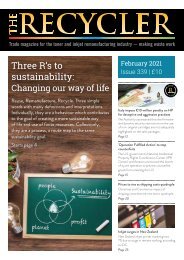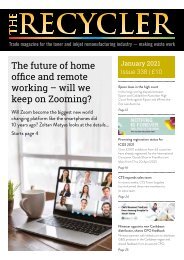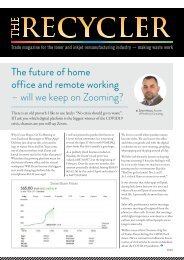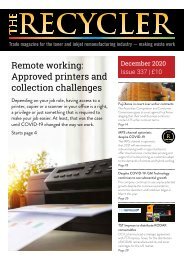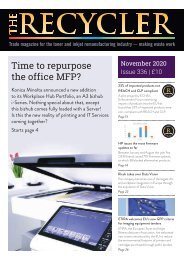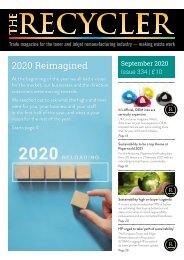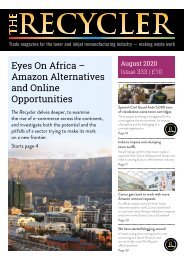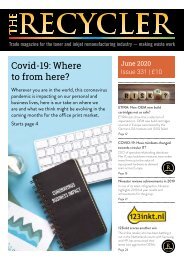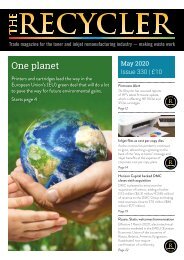The Recycler - Eco Design
Create successful ePaper yourself
Turn your PDF publications into a flip-book with our unique Google optimized e-Paper software.
<strong>The</strong>re are <strong>Eco</strong>-<strong>Design</strong> minimum<br />
requirements for some products<br />
(computers, household appliances, boilers,<br />
etc.) which are intended to reduce their<br />
negative environmental impact during<br />
their life. <strong>The</strong>ir scope can be broad and<br />
include maximum energy consumption to<br />
minimum quantities of recycled material<br />
used in their production. Increasingly, there<br />
are specific and exact values attributed to<br />
these requirements. Generic requirements<br />
do not have limits but, may require<br />
products to be recyclable, maintainable<br />
and minimize environmental impact.<br />
Sometimes, compliance is required before<br />
the product is placed on the market.<br />
Implementing standards<br />
<strong>The</strong> EU also provides design standards<br />
which are regulated. European<br />
standardisation bodies such as CENELEC<br />
develop Standards and Harmonization<br />
processes. But there can be a presumption<br />
of conformity and compliance.<br />
Presumption may not always be effective,<br />
and some industry sectors create Voluntary<br />
Agreements under the EU <strong>Eco</strong>-<strong>Design</strong><br />
legislation. Imaging equipment is covered<br />
by an Industry Voluntary Agreement,<br />
managed through Eurovaprint, providing<br />
environmental performance targets.<br />
It includes copiers, MFDs, printers<br />
and fax machines.<br />
Plastic is an extremely versatile product,<br />
but its ubiquitous use is now recognised as<br />
unsustainable, polluting, and harmful to<br />
the environment. Imaging equipment, like<br />
numerous similar products make ample<br />
use of the material.<br />
It is positive to note that the latest draft<br />
of the 2020 Joint Voluntary Agreement<br />
sets specific requirements for the use of<br />
plastic, fastener types, and non-separable<br />
connections in both print hardware and<br />
cartridges.<br />
This Voluntary Agreement goes a step<br />
further to discuss dismantling and nondestructive<br />
extraction of some components<br />
which are typically separated at the end<br />
of the product life. <strong>Eco</strong>-labeling will<br />
demonstrate compliance to end-users. This<br />
is a good example of how the EU Circular<br />
Action Plan and Green Deal, through <strong>Eco</strong>-<br />
<strong>Design</strong> is slowly starting to have an impact<br />
on an industry.<br />
<strong>Eco</strong>-<strong>Design</strong> is not difficult to achieve.<br />
Its problem is that it is caught between<br />
economic, commercial, and environmental<br />
stakeholder needs. Either Voluntary<br />
industry direction or legal compulsion<br />
will decide the degree and pace of<br />
its implementation in many industries.<br />
Post pandemic, competitive advantage<br />
through <strong>Eco</strong>-<strong>Design</strong> will resonate<br />
well with customers and may prove<br />
a welcome accelerant.<br />
References:<br />
<strong>The</strong> REBus Project: www.rebus.eu.com<br />
University of Cambridge. Industry<br />
Sustainability Research: www.ifm.eng.cam.<br />
ac.uk/research/industrial-sustainability/<br />
CELENEC European Committee for<br />
Electromechanical Standardization:<br />
www.cenelec.eu<br />
EuroVAPrint: www.eurovaprint.eu ■<br />
However you consume your news make sure you engage: Like, Follow and Share





